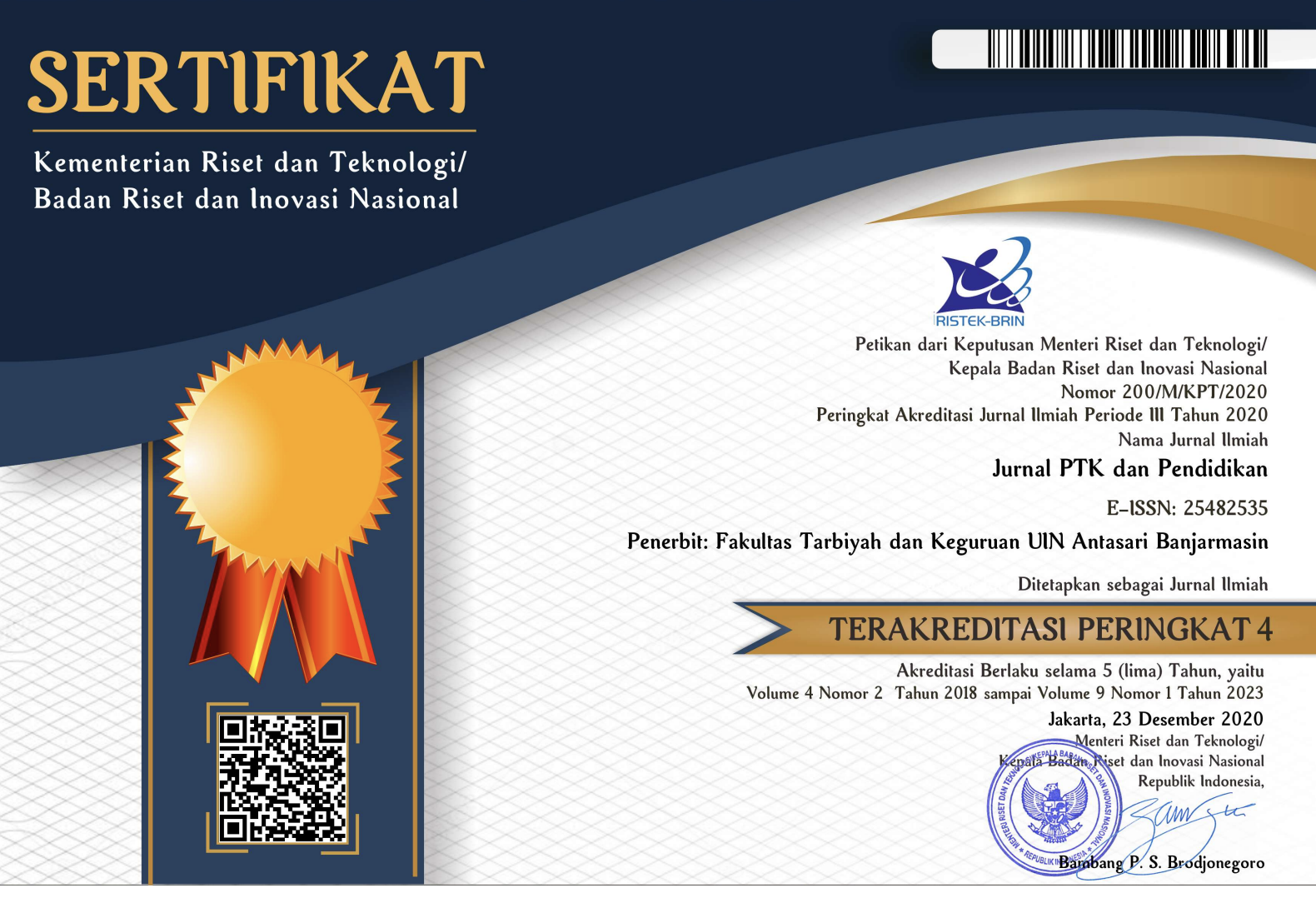NEURO-LINGUISTIC PROGRAMMING (NLP) FOR INTERVENING WITH CHILDREN WHO HAVE LEARNING DIFFICULTIES
DOI:
https://doi.org/10.18592/ptk.v9i2.9855Abstract
In the process of learning, some students may encounter difficulties. To ensure success and achievement in learning, educational institutions, particularly schools, must provide appropriate interventions. These interventions should be directly applied by the teacher. Learning is a crucial aspect of a student's academic journey. Neuro-linguistic programming (NLP) is a form of counseling that can help identify learning difficulties. The objective of this research is to: The research methodology employed was library research with an analytical method, specifically content analysis. The purpose of this research is to explore the application of neuro-linguistic programming in interventions for children with learning difficulties. The findings indicate that neuro-linguistic programming can be used by teachers to build relationships with children and help overcome learning difficulties. By implementing this approach, teachers can map students based on their representation system, which can facilitate building rapport and conducting counseling and therapy using NLP techniques. Additionally, teachers must build closeness with students, use appropriate language during teaching, and provide guidance and counseling to children with learning difficulties.References
Arikunto, S. (2010). Prosedur Penelitian Suatu Pendekatan Praktik. Rineka Cipta.
Dena, S. (2017). Efektivitas Neuro Linguistic Programming untuk meningkatkan Keterampilan Komunikasi Konseling Mahasiswa Program Studi Bimbingan dan Konseling Islam Universtias Islam Negeri Sunan Ampel Surabaya.
Ernawati, L., & Aminah, Y. (2017). Pengaruh Kondisi Fisik Siswa dan Lingkungan Sekolah Terhadap Motivasi Belajar Bidang studi ekonomi Siswa Kelas X MA NU Ibtidaul Falah Kudus Tahun Ajaran 2015/20116. Economic Education Analysis Journal, 6(1).
Hadi, F. Z., & Zubaidah, Z. (2015). Pemanfaatan Konseling Neuro Linguistic Programming dalam Mengatasi Kesulitan Belajar Siswa Sekolah Dasar. Jurnal Dakwah Risalah, 26(4), 174–182.
Huwaida, A. N., Asihanngtyas, F, & Alviah, S. N. (2020). Pengaruh Intelegensi dalam Pendidikan Anak. . . Jurnal NUSANTARA, 2(1), 42–49. https://doi.org/. https://doi.org/10.36088/nusantara.v2i1.537
Ismail. (2016). Diagnosa Kesulitan Belajar Siswa Dalam Pembelajaran Aktif Di Sekolah. Jurnal Edukasi, 2(1), 30–43. http://dx.doi.org/10.22373/je.v2i1.689
Jannah, M. (2015). Pengaruh Peran Orang Tua Dan Kemampuan Mengajar Guru Terhadap Prestasi Belajar Siswa. Jurnal Penelitian Dan Pendidikan IPS, 9(2).
Kuhltau, C. C. (2002). Teaching The Library Research. Scarecrow Press Inc.
Lestari, N. D., Ibrahim, M, Amin, S. M, & Kasiyun, S. (2021). Analisis Faktor-Faktor Yang Menghambat belajar membaca permulaan pada siswa sekolah dasar. Jurnal Basicedu, 5(4), 2611–2616. https://doi.org/10.31004/basicedu.v5i4.1278
Lomu, L., & Widodo, S. A. (2018). Pengaruh Motivasi Belajar dan Disiplin Belajar terhadap Prestasi Belajar Matematika Siswa. Prosiding Seminar Nasional Etnomatnesia.
Nugraheny, D. C., & Kusuma, A. P. (2018). Neurolinguistik Programming dalam Bidang Pendidikan. Buana Pendidikan: Jurnal Fakultas Keguruan Dan Ilmu Pendidikan Unipa Surabaya, 14(26), 167–174. https://doi.org/10.36456/bp.vol14.no26.a1682
Pautina, A. R. (2018). Aplikasi Teori Gestalt Dalam Mengatasi Kesulitan Belajar Pada Anak. Tadbir: Jurnal Manajemen Pendidikan Islam, 6(1), 14–28.
Prastowo, A. (2012). Panduan Kreatif Membuat Bahan Ajar Inovatif. Diva Press.
Rahayu, R., & Susanto, R. (2018). Pengaruh Kepemimpinan Guru dan Keterampilan Manajemen Kelas terhadap Perilaku Belajar Siswa kelas. Jurnal Pendidikan Dasar PerKhasa, 4(2). https://doi.org/10.31932/jpdp.v4i2.178
Salami. (2015). Implementing Neuro Linguistic Programming (NLP) in Changing Students Behavior: Research Done at Islamic Universities in Aceh. Jurnal Ilmiah Peuradeun, 3(2). http://journal.scadindependent.org/index .php/jipeuradeun/article/view/65
Saputri, F. I. (2016). Pengaruh Gaya Belajar Visual, Auditori, dan Kinestetik Terhadap Prestasi Bejajar Siswa. Jurnal Prima Edukasia, 3(1).
Serbaguna, B. S. (2005). Analisis Data Pada Penelitian Kualitatif. UI Press.
Sodik, M., Sahal, Y. F. D., & Herlina, N. H. (2019). Pengaruh Kinerja Guru dalam Pelaksanaan Pembelajaran terhadap Prestasi Belajar Siswa pada Mata Pelajaran Alquran Hadis. Jurnal Penelitian Pendidikan Islam, 7(1). https://doi.org/10.36667/jppi.v7i1.359
Subini, N. (2011). Mengatasi Kesulitan Belajar pada Anak. Javalitera.
Subiyono, Rofiq, Z, & Hariono, A. (2018). Hypno-NLP dalam Proses Belajar Mengajar (Pemanfaatan Potensi Otak Kanan, Alam Bawah Sadar, dan Gelombang Otak. Deepublish.
Susanto, R. (2017). Keterampilan Manajemen kelas Melalui Gerakan Sederhana senam Otak (Brain Gym) di SD Pelita 2 Jakarta Barat. Jurnal Abdimas, 3(2). https://doi.org/10.47007/abd.v3i2.1740
Teddi, P. Y. (2014). NLP The Art of Enjoying Life: Kiat Sederhana Mengelola Pikiran Untuk Hidup Bahagia. Serambi Ilmu Semesta.
Triana, I. K. D. L., & Yanti, N. P. E. D. (2018). Neuro-Linguistic Programming: Solusi Tingkatkan Self-Efficacy Perawat di Rumah Sakit. Jurnal BIMIKI, 6(2). https://doi.org/10.53345/bimiki.v6i2.31
Widoyoko, S. E. P., & Rinawati, A. (2012). Pengaruh Kinerja Guru terhadap Motivasi Belajar Siswa. Jurnal Cakrawala Pendidikan. https://doi.org/10.21831/cp.v5i2.1563
Wikanengsih. (2012). Menerapkan Neurolinguistik Programming (NLP) dalam Pembelajaran. Jurnal Semantik. https://doi.org/10.22460/semantik.v1i1.p%25p
Zahro, N. K. (2017). Pelatihan Neuro Linguistic Programming (NLP) untuk Meningkatkan Kepercayaan Diri. Persona: Jurnal Psikologi Indonesia, 6(1), 40–51.
Downloads
Published
How to Cite
Issue
Section
License
Copyright (c) 2024 Sandy Irsyad, Casmini Casmini

This work is licensed under a Creative Commons Attribution 4.0 International License.
- The right to publication of all journal material published on the Jurnal PTK dan Pendidikan website is held by the editorial board with the author's knowledge (moral rights remain the property of the author).
- The formal legal provisions for access to digital articles of this electronic journal are subject to the terms of the Creative Commons CC BY 4.0 DEED Attribution International (CC BY) license. This license enables reusers to distribute, remix, adapt, and build upon the material in any medium or format, so long as attribution is given to the creator. The license allows for commercial use.
- Printed and electronic published manuscripts are open access for educational, research and library purposes. In addition to these objectives, the editorial board shall not be liable for violations of copyright law.






